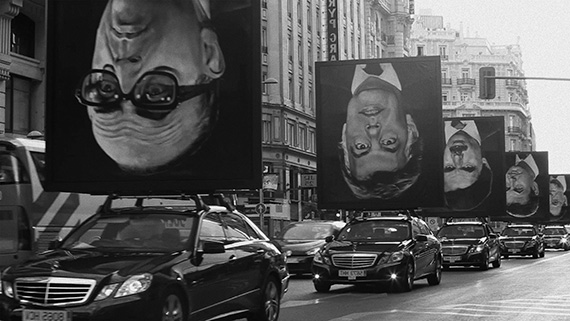 |
| Jorge Galindo and Santiago Sierra, Los Encargados, 2012, image: Galeria Helga de Alvear |
Curated by Katerina Gregos as part of this year’s Göteborg biennial, “The Politics of Play” offers literary segues: It invokes both the words of poet Alan Gilbert —”Politics without the imagination is bureaucracy”—as well as philosopher Herbert Marcuse’s view that poetry, art, imagination, and “the creator spirit” possess the revolutionary power to ignite real change. The notion that poetics and political theory could be equally influential is refreshing, leaving room to discuss how words (and ideas stemming from them) transform our world. And if the biennial’s theme poses relevant questions—how to locate the political potential of any practice, or what steps must be taken to judge a democracy’s worth—its shows set themselves apart only when they do more than just highlight theories. As such, “The Politics of Play” is successful in those places where potential energies become kinetic; in the words of one of the biennial’s participating artists, Tania Bruguera, “Art becomes political when it achieves actual results.”
The show’s most persuasive works provide entrance into the theme from alluring, well-honed vantage points. Olav Westphalen’s selection of poster-size, illustrated comics use humor to interrogate political realities and reconsider preexisting standards of political correctness. In Jorge Galindo and Santiago Sierra’s video, juxtaposed heads of Spanish political figures loom atop a caravan of limousines reminiscent of a funeral procession, in the artists’ attempt to highlight corruption. Otobong Nkanga’s cloth works draw inspiration from East African kanga textiles, whose prints typically relay messages of love. But Nkanga’s version expresses more complex, politically charged messages; its images include twisted wire—the kind that adorns women’s necks—coiled so tightly that it would asphyxiate a wearer, echoing the piece’s title, There’s Only So Much a Neck Can Carry, 2011–12. As is typical for large-scale shows presented in the context of biennials, this one includes older works, which is useful from an archival perspective—but only to an extent. “The Politics of Play” is at its best where the curators have put forth nuanced efforts to embrace current concerns, and to include newer works that directly speak to the exhibition’s thematics.
To see the review in context, click here.








